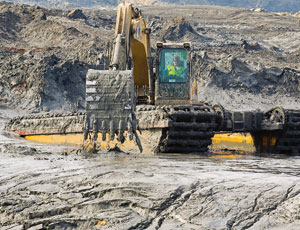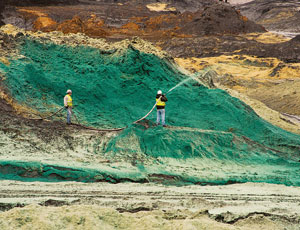The Tennessee Valley Authority has begun the long road to recovery at its Kingston Fossil Plant following a massive coal-ash spill on Dec. 22, 2008. The agency has pledged to make the areas “as good, if not better than they were before” in its long-term cleanup plan filed on March 2 with a Tennessee state agency.


On March 9, the Environmental Protection Agency announced it will tighten EPA coal-ash regulations by the end of the year as a result of the dike failure that caused 5.4 million cu yd of wet coal ash to flood 300 acres, including a portion of the adjacent Emory River. EPA also has asked utilities to report on the structural integrity of the more than 300 coal-ash ponds in the U.S., and it will independently evaluate those reports.
After what TVA President Tom Kilgore called a “catastrophe,” TVA hired Los Angeles-based AECOM Technology Corp. to investigate, overseen by the Tennessee Dept. of Environment and Conservation. Five drill rigs are testing the failed dredge-cell area.
“There are many dimensions to the TVA coal-ash-impoundment release that will be investigated,” says Bruce Tschantz, professor emeritus of civil and environmental engineering at the University of Tennessee. He is on a TDEC advisory panel that will oversee and review the root-cause analysis.
TDEC ordered the study as part of TVA’s long-term corrective action plan. The plan outlines what TVA will do to restore the area, monitor air and water quality, protect water supplies and address Kingston’s coal-ash management. TVA says it will likely switch from wet to dry storage at all its coal plants and sell all qualifying ash for use as a cement replacement in ready-mix concrete.
TVA also has filed a detailed dredging plan to begin clearing the Emory River. That plan, prepared by Shaw Environmental Inc., Baton Rouge, was approved after revisions to include additional monitoring, says TDEC spokeswoman Tisha Calabrese-Benton.
TVA has hired Jacobs Engineering Group, Pasadena, Calif., to manage procurement and construction at the site, says Gil Francis, a TVA spokesman. Contractors did not return calls or said they could not comment on the work.
Contractor Trans-Ash Inc., Cincinnati, will dredge the Emory River to 710- ft mean sea level using hydraulic and mechanical dredging. A clamshell bucket and a specially designed rake and grapple will remove debris mechanically. A 10-in.-dia. pipe will move the dredged coal ash to a dewatering area.
This spring, TVA will begin a second phase of dredging, which will restore the Emory River to its original level. A third phase of the dredging will remove ash in areas outside of the river, at which point work will also focus on removing ash from land areas. TVA has not yet submitted phase-two or -three plans or plans to handle and move the coal ash after it is dredged from the river.
Until now, TVA has focused on monitoring and stabilizing the ash. Contractors built a 615-ft-long underwater weir in the river and a 1,750-ft-long dike across a pond nearby to secure the ash. TVA also built an embankment along one of the dikes that showed compression cracks and a steep scarp line as result of the failure. TVA is monitoring another dike for scouring because of changes in river flows.
A report on the 2008 annual inspection of the plant dikes, released in mid-February, found no major problems in the dikes before the accident. At the end of a Jan. 12 draft of the report, a TVA engineer wrote, “Subsequent to the inspection and prior to writing this inspection report a dike failure at the north end of the dredge cells occurred. None of the observations noted during this inspection indicated a dike failure.”
Immediately after the spill, TVA speculated that heavy rains and freezes might have contributed to the dike failure.

Post a comment to this article
Report Abusive Comment